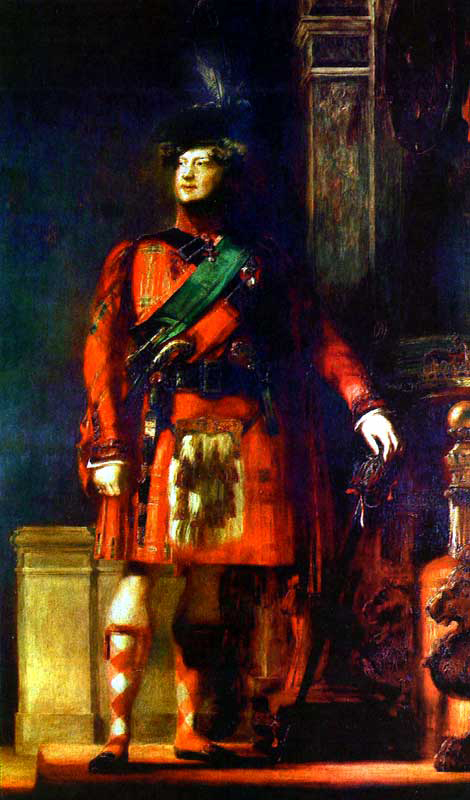Kings and Queens of Scotland - George I to Queen Victoria.
House of Hanover (1714 – 1901)
DETERMINED that England should retain its religious infrastructure, the Act of Settlement which was introduced at the start of the childless Queen Anne's reign in 1701, decreed that upon her death the British Crown should bi-pass forty-two Catholic claimants in favour of the nearest Protestant candidate. That candidate, as it transpired, was Sophia, daughter of James VI's daughter Elizabeth, who had married Frederick, Elector of Palatine.
In 1707, this legislation was incorporated into the Act of Union between Scotland and England, which dissolved the Scottish Parliament in favour of a single British parliament based in London. Although Queen Anne was certainly sympathetic to her half-brother's claim to the succession, the fact remains that when she died in 1714 the British Government chose Sophia's eldest son, George.
1714-27 George I
THE Elector of Hanover, now George I of England, arrived in London unable to speak a word of English and anxious to use his new found position to obtain advantages for his German principality. Had his cousin James Francis, the “de jure King over the Water” been of stronger character, and had his supporters more honourable, the exiled Stuarts might easily have reversed the situation. As it was, the first Jacobite Rising of 1715, led by the Earl of Mar in Scotland, failed dismally.
1727- 60 George II
GEORGE II succeeded his father as King of Great Britain and Ireland in 1727. In 1742, Britain took part in the War of Austrian Succession. Then in 1745, Prince Charles Edward Stuart, the “Young Pretender” sailed from France and landed on the Hebridean isle of Eriskay. Within two months he had raised a Highland army and marched on Edinburgh to take up residence at Holyrood Palace. At Market Cross, his father was proclaimed as James III of England and James VIII of Scotland. On 21st September, Government troops were routed at the Battle of Prestonpans and the Jacobite army marched south into England, reaching Derby on 4th December, 1745. It seemed that nothing could stop them. Had Bonny Prince Charlie pressed home his advantage and marched on London, the entire course of British history would have changed dramatically, but the fatal decision was taken to return to Scotland and postpone the invasion until the following year. The Government victory at the Battle of Culloden Moor in April 1746 destroyed once and for all any hope of the House of Stuart retrieving its lost inheritance. Prince Charles Edward Stuart retreated to Rome, where his brother James was a Cardinal. George II died unexpectedly at the age of seventy seven and was succeeded by his grandson.
1760- 1820 George III
DURING George III's reign, Britain's American colonies, exasperated by taxation, rebelled and, in 1873, achieved independence. Britain was also preoccupied with a series of wars against post-revolution France and the Emperor Napoleon, which came to an end in 1815. Despite moments of brilliance, the King suffered from regular bouts of mental illness and from 1810, his son, the Prince of Wales, acted as Regent. King George himself never set foot in Scotland.
 |
George IV, Sir David Wilkie (1785-1841) Oil on canvas, 1829 |
GEORGE IV was the first Hanoverian Monarch to pay a visit to Scotland, arriving in Leith in 1822. He spent three weeks in Edinburgh and hosted a grand reception for Scottish society at the Palace of Holyrood, much in keeping with the lavish lifestyle he had adopted. He had married Princess Caroline of Brunswick in return for the British parliament paying his debts, but a scandalous divorce ensued.
1830-37 William IV
“THE Sailor King”, so called for having served in the Royal Navy, William, Duke of Clarence and St Andrews, succeeded his brother in 1830. Having set up house with the actress Mrs Jordan, who bore him ten children, he married Adelaide, daughter of the Duke of Saxe-Meiningen in 1818. Both their daughters died in infancy.
1837- 1901 Victoria
THE only child of George III's fourth son, Edward, Duke of Kent, Victoria succeeded her uncle in 1837. In 1842, she and her husband Prince Albert of Saxe-Coburg-Gotha made their first visit to Scotland and purchased Balmoral Castle in Aberdeenshire in 1848. From then on the precedent of the Royal family spending their holidays on Deeside was set, and the Scottish Highlands took on a special significance as a fashionable sporting playground for the rich. The reign of Queen Victoria ushered in the Industrial Revolution, and Britain prospered as never before with the British Empire reaching into the far corners of the world. In 1876, Victoria became Empress of India. Her reign spanned sixty three years and she died at her home on the Isle of Wight in January 1901.
























